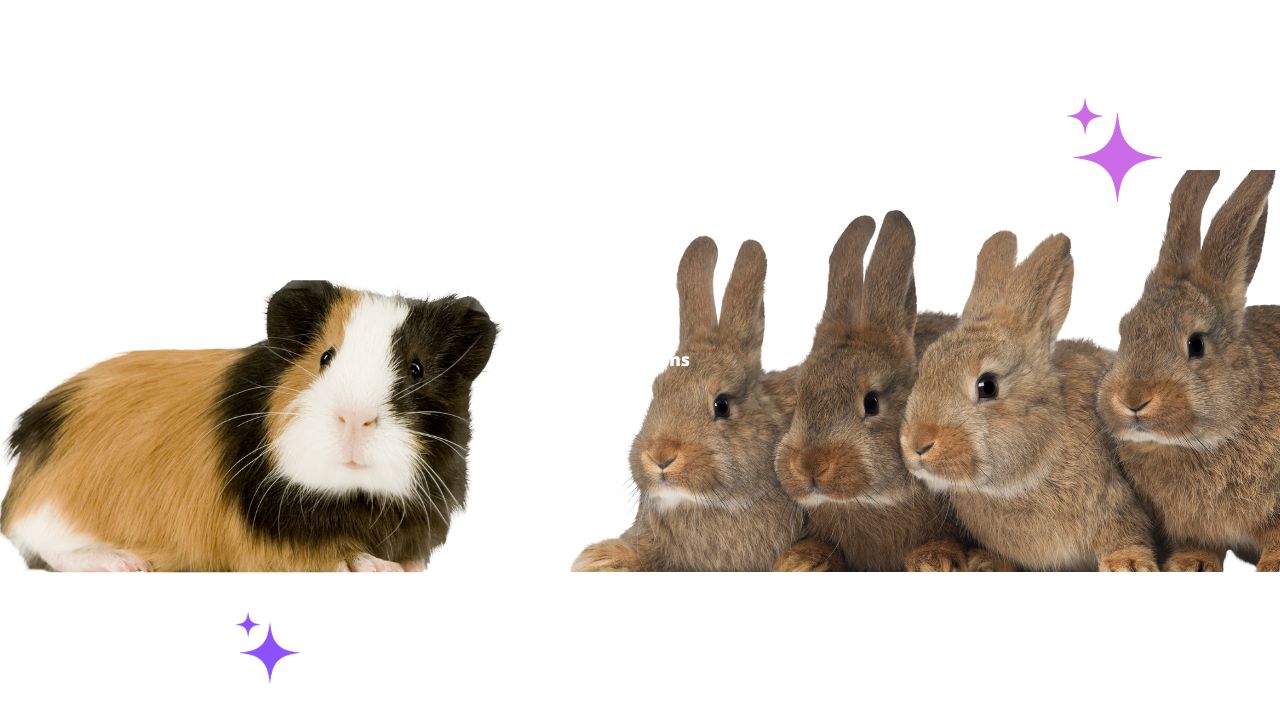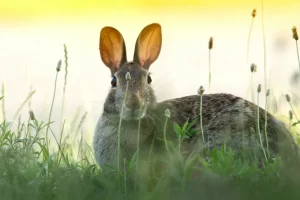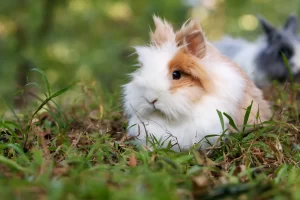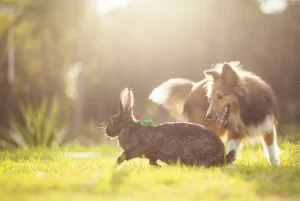Did you know that rabbits and guinea pigs are both popular pets, but have you ever wondered if they can live together? In this article, we will explore the possibility of these furry friends cohabiting.
With a little understanding of their differences in care and diet, as well as their social dynamics, you can create a harmonious living environment for both. So, if you’re considering housing a rabbit and guinea pig together, read on to discover what you need to know.
In This Article
- 1 Key Takeaways
- 2 Differences in Care and Diet
- 3 Understanding Social Dynamics
- 4 Introducing the Pets
- 5 Providing Adequate Space
- 6 Monitoring for Signs of Stress
- 7 Handling Potential Health Risks
- 8 Resolving Potential Conflicts
- 9 Seeking Professional Advice
- 10 Frequently Asked Questions
- 10.1 Can Rabbits and Guinea Pigs Share the Same Cage or Enclosure?
- 10.2 What Are the Common Behavioral Differences Between Rabbits and Guinea Pigs?
- 10.3 How Do Rabbits and Guinea Pigs Communicate With Each Other?
- 10.4 Can Rabbits and Guinea Pigs Be Left Alone Together Without Supervision?
- 10.5 Are There Any Specific Toys or Activities That Are Suitable for Both Rabbits and Guinea Pigs?
- 11 Conclusion
Key Takeaways
- Rabbits and guinea pigs have different dietary needs, with rabbits requiring a diet rich in fiber and guinea pigs needing vitamin C supplementation.
- Rabbits are more active and need more space to hop around and explore, while guinea pigs are less active and can thrive in a smaller living space.
- It is important to observe the existing group’s behavior and communication patterns before introducing a new pet, and to introduce the new rabbit or guinea pig gradually.
- Providing adequate space is crucial, with rabbits needing at least 10 square feet of space and guinea pigs needing at least 7.5 square feet, as well as daily supervised exercise time outside the cage.
Differences in Care and Diet
You should consider the differences in care and diet when deciding to keep a rabbit and guinea pig together. Both animals have specific nutritional requirements and exercise needs that must be met for their overall health and well-being.
Rabbits are herbivores and require a diet rich in fiber, such as hay and fresh vegetables. On the other hand, guinea pigs need vitamin C supplementation as they can’t produce it on their own.
When it comes to exercise, rabbits are more active and require more space to hop around and explore, while guinea pigs are less active and can thrive in a smaller living space.
It’s crucial to provide separate feeding areas and ensure that each animal is receiving the appropriate diet and exercise for their specific needs. By understanding these differences, you can create a harmonious living environment for both your rabbit and guinea pig.
Understanding Social Dynamics
The understanding of social dynamics is crucial when introducing a new rabbit or guinea pig to an existing group of pets. To ensure a smooth transition and minimize stress, it’s important to consider the communication patterns and hierarchy establishment within the group.
Here are three key points to keep in mind:
- Observation: Before introducing the new pet, carefully observe the existing group’s behavior and communication patterns. This will help you understand their dynamics and identify any potential challenges.
- Introduction: Introduce the new rabbit or guinea pig gradually, starting with short supervised interactions. This allows the animals to become familiar with each other’s scents and behaviors, reducing the chances of aggression.
- Hierarchy Establishment: During the introduction process, it’s natural for the group to establish a hierarchy. Allow the animals to establish their own pecking order, but intervene if any aggression becomes excessive or harmful.
Introducing the Pets
Fortunately, when introducing a new pet to your existing group, slowly and steadily is the key.
Compatibility concerns should be taken into consideration when introducing different species, such as rabbits and guinea pigs, to ensure a harmonious living environment. Rabbits and guinea pigs have different social behaviors and communication styles, which can lead to misunderstandings and potential conflicts.
To avoid any potential issues, it’s important to introduce them gradually. Start by allowing them to interact through a barrier, such as a cage or a gate, to get used to each other’s presence. Then, supervised face-to-face introductions can be arranged in a neutral space.
Observe their interactions closely and be prepared to intervene if necessary. With patience and proper introductions, rabbits and guinea pigs can coexist happily and form a bond that enriches their lives.
Providing Adequate Space
To ensure a comfortable living environment for both your rabbit and guinea pig, it’s essential to provide adequate space and access to separate areas.
Here are some tips to meet their housing requirements and ensure sufficient exercise:
- Cage Size: Provide a spacious cage that’s large enough for both animals to move around freely. A minimum of 10 square feet is recommended for a rabbit, while a guinea pig needs at least 7.5 square feet.
- Separate Areas: Create separate areas within the cage to give each pet their own space. This can be done by using dividers or providing separate hides and feeding areas.
- Exercise Time: Allow daily supervised exercise time outside the cage. Rabbits need at least 3-4 hours of exercise, while guinea pigs require 1-2 hours. Provide a safe and enclosed space for them to explore and stretch their legs.
Monitoring for Signs of Stress
If you notice any changes in behavior or physical symptoms, such as loss of appetite or excessive grooming, it is important to monitor your rabbit and guinea pig closely as these could be signs of stress. Recognizing behavioral changes is crucial in ensuring the well-being of your pets. Creating a safe and secure environment for them is essential to prevent stress-related issues.
| Behavioral Changes | Possible Causes | Recommended Actions |
|---|---|---|
| Loss of appetite | Stress, illness | Monitor closely and consult a veterinarian if necessary |
| Excessive grooming | Boredom, anxiety | Provide enrichment activities, such as toys or playtime |
| Aggressive behavior | Territorial disputes | Separate the animals, provide separate living spaces |
Handling Potential Health Risks
You should always be proactive and take necessary precautions to minimize potential health risks for your rabbit and guinea pig. Here are three important steps to help you manage allergies and prevent cross contamination:
- Keep separate living spaces: Rabbits and guinea pigs have different dietary needs and can carry different types of bacteria. It’s best to provide them with separate enclosures to prevent the spread of germs and reduce the risk of cross-contamination.
- Practice good hygiene: Wash your hands thoroughly before and after handling each pet to minimize the transfer of allergens. Regularly clean their living spaces, including cages and bedding, to maintain a clean and healthy environment.
- Manage allergies carefully: If you or someone in your household is allergic to either rabbits or guinea pigs, consult with a healthcare professional to develop a management plan. This may include using allergy medications, keeping the pets in designated areas, or considering alternative housing options.
Resolving Potential Conflicts
To resolve potential conflicts between your rabbit and guinea pig, you can establish clear boundaries and communicate effectively with both pets. Behavior modification techniques can be used to address any aggressive or territorial behaviors between the two animals. By implementing positive reinforcement and redirecting their attention towards more appropriate activities, you can encourage them to coexist peacefully. Additionally, establishing a hierarchy within their shared living space is crucial. This can be done by providing separate feeding areas, hiding spots, and play areas for each pet. To help you visualize this, here is a table outlining the different elements that can be incorporated into their living space:
| Element | Rabbit | Guinea Pig |
|---|---|---|
| Feeding Area | One corner | Opposite corner |
| Hiding Spot | Under the bed | Behind the couch |
| Play Area | Open space | Enclosed pen |
| Bedding Material | Straw | Hay |
| Toys | Chew toys | Tunnel |
Seeking Professional Advice
You can consult with a veterinarian or animal behaviorist for professional advice on resolving conflicts between your rabbit and guinea pig. Seeking professional advice is crucial to ensure the well-being and compatibility of your pets.
Here are three reasons why professional advice is important in assessing the compatibility of your rabbit and guinea pig:
- Expert Knowledge: Veterinarians and animal behaviorists have extensive knowledge and experience in understanding the behavior and needs of different species. They can provide valuable insights into the compatibility of rabbits and guinea pigs based on their individual temperaments and social dynamics.
- Behavior Modification Techniques: Professionals can offer specific behavior modification techniques to address any conflicts that may arise between your rabbit and guinea pig. They can guide you on how to introduce the pets properly, establish a harmonious environment, and manage any territorial or aggressive behaviors.
- Health Considerations: Professionals can also assess the health of both your rabbit and guinea pig to determine if there are any underlying medical issues that may be contributing to conflicts. They can provide guidance on proper care, nutrition, and any necessary medical interventions to promote the well-being of both pets.
Frequently Asked Questions
Yes, rabbits and guinea pigs can share the same cage or enclosure. They have housing compatibility and can form inter species bonding opportunities. It is important to introduce them properly and monitor their interactions.
What Are the Common Behavioral Differences Between Rabbits and Guinea Pigs?
Behavioral traits and social interaction are important factors to consider when thinking about keeping a rabbit and guinea pig together. Understanding their differences can help you create a harmonious environment for both pets.
How Do Rabbits and Guinea Pigs Communicate With Each Other?
Rabbits and guinea pigs communicate through body language and vocalizations. They have similar body language cues, such as ear positioning and tail wagging. Both use vocalizations like squealing and purring to express themselves.
Can Rabbits and Guinea Pigs Be Left Alone Together Without Supervision?
Yes, rabbits and guinea pigs can be left alone together without supervision. They have compatible diets and can coexist peacefully. However, it’s important to provide enough space, hideouts, and separate food bowls to prevent any potential conflicts.
Are There Any Specific Toys or Activities That Are Suitable for Both Rabbits and Guinea Pigs?
There are interactive feeding toys available for both rabbits and guinea pigs. You can also create DIY play areas for them to enjoy. It’s important to provide suitable toys and activities for both to keep them entertained and happy.
Conclusion
In conclusion, while it’s possible for a rabbit and guinea pig to live together, it requires careful consideration and proper preparation to ensure their well-being. By understanding their differences in care and diet, introducing them properly, providing adequate space, and monitoring for signs of stress, you can create a harmonious living environment.
For example, Sarah successfully introduced her rabbit and guinea pig by gradually introducing them and providing separate spaces for feeding and resting, resulting in a happy and bonded pair.
Remember to seek professional advice for any specific concerns or issues.





